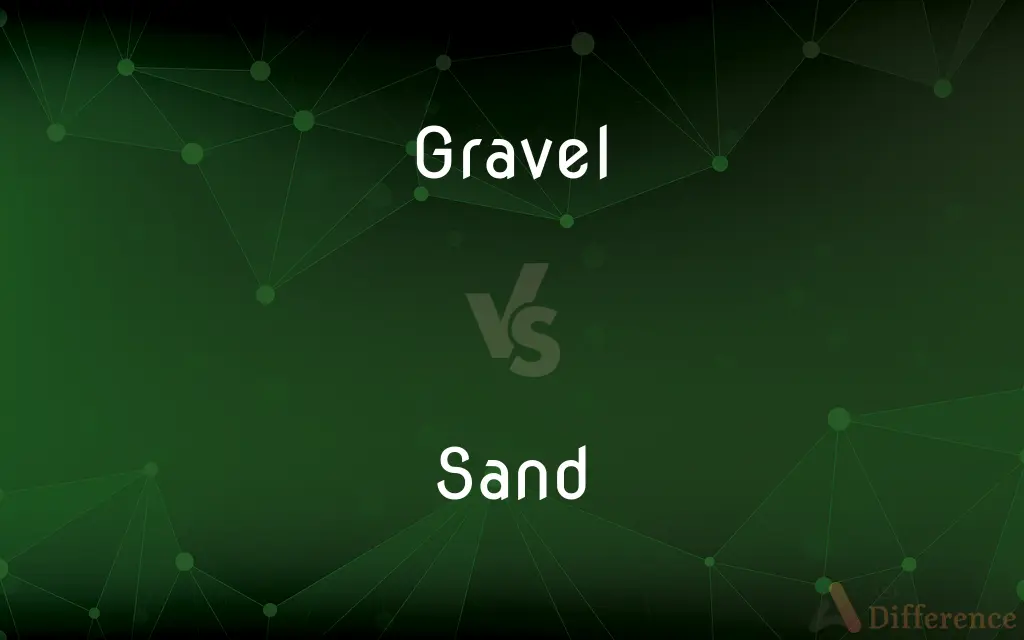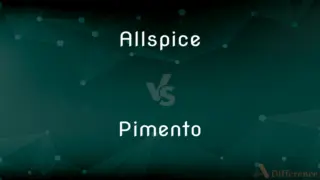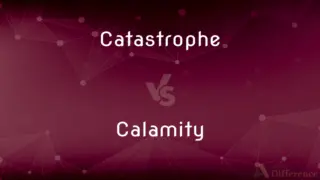Gravel vs. Sand — What's the Difference?
By Tayyaba Rehman — Updated on September 27, 2023
Gravel consists of small, rounded stones, often used for driveways and paths. Sand is composed of finely divided rock and mineral particles, commonly found on beaches and deserts. Both are natural substances with varying uses.

Difference Between Gravel and Sand
Table of Contents
ADVERTISEMENT
Key Differences
Gravel is a collection of small, rounded stones of varying sizes, often used in construction for making concrete or as a surface layer for driveways and paths. In contrast, sand consists of finer, smaller particles of eroded rocks, minerals, and organic materials, primarily used in construction, manufacturing, and for beaches. Both gravel and sand have unique characteristics and applications, varying in texture, size, and use.
Gravel is typically larger and has a coarser texture compared to sand. It provides better drainage due to the spaces between the stones, making it suitable for use in landscaping and for creating a permeable layer in gardens. Sand, however, has smaller and finer particles, making it apt for creating smooth textures, used in plastering, making glass, and various other applications in the construction industry.
In construction, gravel serves as a primary component in the formation of concrete, when mixed with sand and cement. Sand also plays a crucial role in construction and manufacturing processes, being a key component in concrete, mortar, and glass-making, due to its fine granular structure which helps in binding materials together.
Gravel, due to its varied sizes and aesthetic appeal, is also used for decorative purposes in landscaping, providing a contrasting texture and color in gardens and pathways. Sand, due to its smooth texture and availability, is utilized in recreational spaces like beaches, playgrounds, and golf bunkers, offering a soft surface and facilitating drainage.
The source of gravel can be from natural erosion or mechanical processes, usually resulting in rounded stones due to the weathering effect. Sand is usually formed by the natural erosion of rocks over time, primarily found in river beds, ocean floors, and deserts, presenting a finer and more consistent grain size compared to gravel.
ADVERTISEMENT
Comparison Chart
Particle Size
Larger, coarser particles.
Smaller, finer particles.
Composition
Rounded stones of varied sizes.
Finely divided rock and mineral particles.
Uses
Driveways, paths, concrete.
Construction, beaches, glass-making.
Texture
Rough and irregular.
Smooth and consistent.
Drainage Capability
Better due to spaces between stones.
Poorer due to smaller, closer particles.
Compare with Definitions
Gravel
Gravel is a coarse aggregate used in concrete production.
The builders mixed cement with gravel to create strong concrete.
Sand
Sand is composed of fine, granular particles of eroded rocks and minerals.
The children enjoyed building castles with the sand at the beach.
Gravel
Gravel can be used for decorative landscaping purposes due to its varied sizes and colors.
They used colorful gravel to adorn the garden pathways.
Sand
Sand is a common component in construction materials like concrete and mortar.
The workers mixed sand with cement to form a smooth mortar.
Gravel
Gravel is a loose aggregation of rock fragments. Gravel is classified by particle size range and includes size classes from granule- to boulder-sized fragments.
Sand
Sand has a smoother and more consistent texture compared to gravel.
The smooth sand was perfect for walking barefoot along the shore.
Gravel
An unconsolidated mixture of rock fragments or pebbles.
Sand
Sand is a granular material composed of finely divided rock and mineral particles. Sand has various compositions but is defined by its grain size.
Gravel
(Medicine) The sandlike granular material of urinary calculi.
Sand
Small loose grains of worn or disintegrated rock.
Gravel
To apply a surface of rock fragments or pebbles to.
Sand
(Geology) A sedimentary material, finer than a granule and coarser than silt, with grains between 0.06 and 2.0 millimeters in diameter.
Gravel
To confuse; perplex.
Sand
Often sands A tract of land covered with sand, as a beach or desert.
Gravel
(Informal) To irritate.
Sand
The loose, granular, gritty particles in an hourglass.
Gravel
(uncountable) Small fragments of rock, used for laying on the beds of roads and railways, and as ballast.
Sand
Sands Moments of allotted time or duration
"The sands are numb'red that makes up my life" (Shakespeare).
Gravel
A type or grade of small rocks, differentiated by mineral type, size range, or other characteristics.
Sand
(Slang) Courage; stamina; perseverance
"She had more sand in her than any girl I ever see.
In my opinion she was just full of sand" (Mark Twain).
Gravel
A particle from 2 to 64 mm in diameter, following the Wentworth scale.
Sand
A light grayish brown to yellowish gray.
Gravel
Kidney stones; a deposit of small calculous concretions in the kidneys and the urinary or gall bladder; also, the disease of which they are a symptom.
Sand
To sprinkle or cover with or as if with sand.
Gravel
A lameness in the foot of a horse, usually caused by an abscess.
Sand
To polish or scrape with sand or sandpaper.
Gravel
(rare) Inability to see at night; night blindness.
Sand
To mix with sand.
Gravel
Gravel cycling, a discipline in cycling different from road cycling, mountain biking or cyclocross, for a large part on gravel roads, typically with a dedicated gravel bike
Sand
To fill up (a harbor) with sand.
Gravel
(transitive) To apply a layer of gravel to the surface of a road, etc.
Sand
(uncountable) Rock that is ground more finely than gravel, but is not as fine as silt (more formally, see grain sizes chart), forming beaches and deserts and also used in construction.
Gravel
To puzzle or annoy.
Sand
A beach or other expanse of sand.
The Canadian tar sands are a promising source of oil.
Gravel
To run (as a ship) upon the gravel or beach; to run aground; to cause to stick fast in gravel or sand.
Sand
Personal courage.
Gravel
To check or stop; to confound; to perplex.
Sand
A particle from 62.5 microns to 2 mm in diameter, following the Wentworth scale.
Gravel
To hurt or lame (a horse) by gravel lodged between the shoe and foot.
Sand
A light beige colour, like that of typical sand.
Gravel
Small stones, or fragments of stone; very small pebbles, often intermixed with particles of sand.
Sand
A single grain of sand.
Gravel
A deposit of small calculous concretions in the kidneys and the urinary or gall bladder; also, the disease of which they are a symptom.
Sand
A moment or interval of time; the term or extent of one's life (referring to the sand in an hourglass).
Gravel
To cover with gravel; as, to gravel a walk.
Sand
(colloquial) A sandpiper.
Gravel
To run (as a ship) upon the gravel or beach; to run aground; to cause to stick fast in gravel or sand.
When we were fallen into a place between two seas, they graveled the ship.
Willam the Conqueror . . . chanced as his arrival to be graveled; and one of his feet stuck so fast in the sand that he fell to the ground.
Sand
Of a light beige colour, like that of typical sand.
Gravel
To check or stop; to embarrass; to perplex.
When you were graveled for lack of matter.
The physician was so graveled and amazed withal, that he had not a word more to say.
Sand
(transitive) To abrade the surface of (something) with sand or sandpaper in order to smooth or clean it.
Gravel
To hurt or lame (a horse) by gravel lodged between the shoe and foot.
Sand
(transitive) To cover with sand.
Gravel
Rock fragments and pebbles
Sand
To blot ink using sand.
Gravel
Cause annoyance in; disturb, especially by minor irritations;
Mosquitoes buzzing in my ear really bothers me
It irritates me that she never closes the door after she leaves
Sand
Fine particles of stone, esp. of siliceous stone, but not reduced to dust; comminuted stone in the form of loose grains, which are not coherent when wet.
That finer matter, called sand, is no other than very small pebbles.
Gravel
Cover with gravel;
We gravelled the driveway
Sand
A single particle of such stone.
Gravel
Be a mystery or bewildering to;
This beats me!
Got me--I don't know the answer!
A vexing problem
This question really stuck me
Sand
The sand in the hourglass; hence, a moment or interval of time; the term or extent of one's life.
The sands are numbered that make up my life.
Gravel
Unpleasantly harsh or grating in sound;
A gravelly voice
Sand
Tracts of land consisting of sand, like the deserts of Arabia and Africa; also, extensive tracts of sand exposed by the ebb of the tide.
Gravel
Gravel consists of small, rounded, and often smooth stones.
We spread gravel on our driveway for better traction.
Sand
Courage; pluck; grit.
Gravel
Gravel is typically larger than sand, providing better drainage.
We added gravel to the plant beds to improve water drainage.
Sand
To sprinkle or cover with sand.
Gravel
Gravel can be sourced from natural erosion or mechanical processes.
The gravel in our yard came from a local riverbed.
Sand
To drive upon the sand.
Sand
To bury (oysters) beneath drifting sand or mud.
Sand
To mix with sand for purposes of fraud; as, to sand sugar.
Sand
A loose material consisting of grains of rock or coral
Sand
French writer known for works concerning women's rights and independence (1804-1876)
Sand
Fortitude and determination;
He didn't have the guts to try it
Sand
Rub with sandpaper;
Sandpaper the wooden surface
Sand
Sand is often used for recreational purposes in areas like beaches and playgrounds.
The sand in the playground provided a soft landing for the kids.
Sand
Sand can be found in various locations including deserts, riverbeds, and ocean floors.
The desert landscape was dominated by miles of shifting sand.
Common Curiosities
What is gravel?
Gravel consists of small, rounded stones of varying sizes, used in construction and landscaping.
What is sand?
Sand is composed of fine, granular particles of eroded rocks and minerals, used in construction and recreation.
Can gravel be used in construction?
Yes, gravel is used as a coarse aggregate in concrete production and as a surface layer for driveways and paths.
Does gravel offer better drainage than sand?
Yes, gravel offers better drainage due to the larger spaces between the stones compared to the closer particles of sand.
Where is sand commonly found?
Sand is commonly found in deserts, beaches, riverbeds, and ocean floors.
Is sand smoother than gravel?
Yes, sand has a smoother and more consistent texture compared to the rough and irregular texture of gravel.
Is gravel larger than sand?
Yes, gravel typically has larger and coarser particles compared to the smaller and finer particles of sand.
Can sand be used in landscaping?
Yes, sand can be used in landscaping, especially in creating smooth surfaces and facilitating drainage.
Can gravel be used for decorative purposes?
Absolutely, gravel can be used for decorative purposes in landscaping, providing varied texture and color.
How is gravel formed?
Gravel can be formed by natural erosion or mechanical processes, often resulting in rounded stones due to weathering.
Is sand used in manufacturing?
Yes, sand is used in various manufacturing processes, such as glass-making, due to its fine granular structure.
Is gravel suitable for landscaping?
Yes, gravel is suitable for landscaping due to its aesthetic appeal and varied sizes and colors.
Can the texture of sand be altered?
The texture of sand is naturally determined by its formation process, but it can be sifted to achieve a desired level of fineness.
How is sand formed?
Sand is formed by the natural erosion of rocks over time, with the particles being finely divided and consistent in size.
Are gravel and sand renewable resources?
While both are abundant, they are technically non-renewable as their formation takes extensive geological time.
Share Your Discovery

Previous Comparison
Allspice vs. Pimento
Next Comparison
Catastrophe vs. CalamityAuthor Spotlight
Written by
Tayyaba RehmanTayyaba Rehman is a distinguished writer, currently serving as a primary contributor to askdifference.com. As a researcher in semantics and etymology, Tayyaba's passion for the complexity of languages and their distinctions has found a perfect home on the platform. Tayyaba delves into the intricacies of language, distinguishing between commonly confused words and phrases, thereby providing clarity for readers worldwide.














































